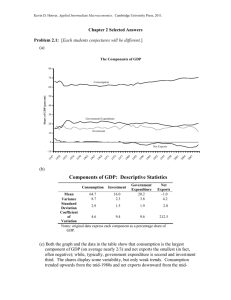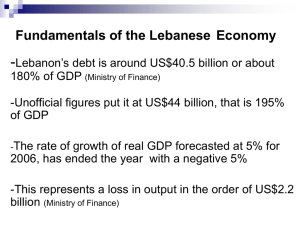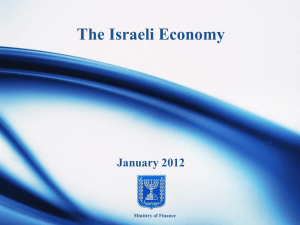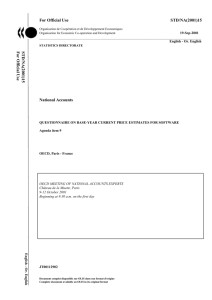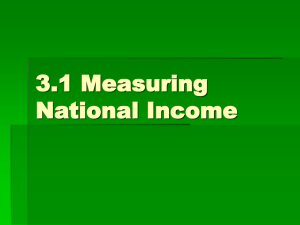01-Introduction, Circular Flow, Classification, Data - OIC
advertisement
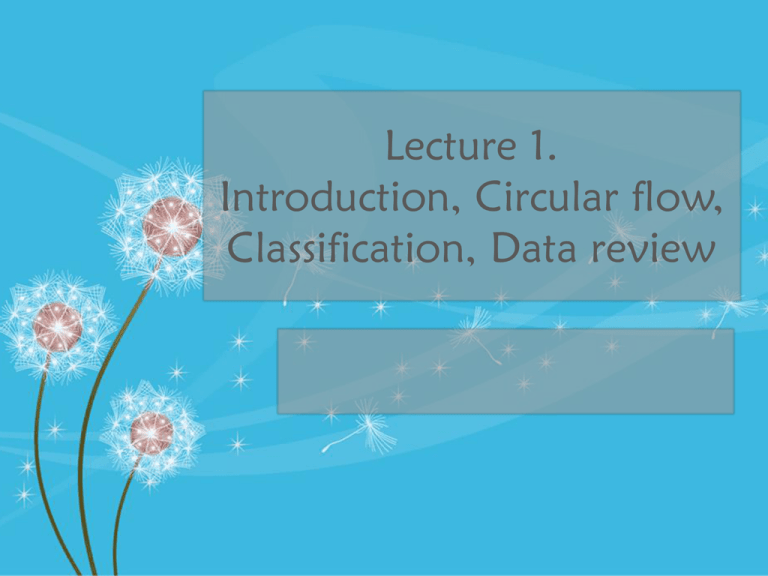
Lecture 1. Introduction, Circular flow, Classification, Data review Resources of the country Human (people) Financial (currency, bank deposit, bonds, corporate equity, etc.) Natural (land, forest, water, biota, air, space, etc.) Produced (building, machinery, goods, technology, etc.) 2 Integrated framework Human Natural Produced Financial • provides labor as means of production • reproduce itself • manage resources • use as means and input to production • reproduce itself • absorb waste • means of production • input to production • means of exchange • produced with transactions 3 Types of variable • Stock - measures at a certain point in time • Flow - measure of variables during a period of time flow stock Stocks • Value of assets at a POINT IN TIME – Non Financial and Financial Assets – Financial liabilities – Net worth • Recorded at the beginning and end of reference period 5 Economic flows Flows that results in change of: • Value • Volume • Compositions • Ownership of economic assets 6 Types of economic flows • • • • Goods & services Distributive (income) Financial (financial instruments) Other accumulation entries 7 Types of economic flows Economic flows • Goods & services • Distributive • Financial • Other accumulation entries Level measured NATIONAL NATIONAL, INSTITUTIONL 8 Economic flows & account Economic flows • Goods & services • Distributive (income) • Financial • Other accumulation entries Accounts Supply & use tables Income & use of income account Financial account Other value change 9 Produced Goods and services Circular Flow of: Expenditures on goods and services Resident owners of economic assets, enterprise,consum er,etc Factors of production (economic assets) Resident producers of goods and services 1. goods and services, 2.economic assets 3. income Factor Income (value added) within the economy 10 Imports of goods and services Exports of goods and services Flow of: Rest of the world Domestic economy Exports of economic assets (investments) and labour 1.goods and services, 2.economic assets, 3.income Factor Income between economy and rest of the world (ROW) 11 Flows of regional factors income Outside territory/ ROW Factors of Production Factors of Production Compensation Producers Compensation Transfer Factors of Production Compensation Consumers What is GDP/GRDP ? Three approaches of GDP/GRDP: Production approach Income approach Expenditure approach Gross Domestic Product • Measured from the production of goods and services • Measured from the expenditure on these goods and services • Measured from the income generated from production of goods and services 15 Gross Domestic Product GDP by production Measured from producers GDP by expenditure Measured from users GDP by income generation Measured from producers 16 How the GDP is measured? • GDP by production is measured by type of industry or type of economic activity • GDP by expenditure is measured by what the goods are used for in final demand, that is whether for consumption, capital formation or export • GDP by income is measured by the payment of producers to the different resources used in production including payment to government. 17 Production approach Value of products produced in a domestic territory within a certain period of time, or value of production/output less intermediate cost/input, or commonly known as : “Gross Value Added (GVA)” Production approach … (2) GDP (GRDP) = Σ GVAi i = Industries Income approach Value of total income (compensation) received by production factors which is owned or possessed by residents of territory within a certain period of time. Income approach… (2) Due to data limitations, GDP/GRDP compilation using this method is not available for both annual or quarterly basis. Expenditures approach “final” expenditures on various goods and services bound for final consumption (households, NPISH, and government), physical investment (GFCF & changes in inventory), and net export (X-M) in a certain territory within a certain period of time. Expenditures approach … (2) GDP by expenditure is widely utilise in analysis of macro economic, which is symbolize in keynessian identity: Y=C+G+I+(X–M) Y = GDP C = households consumption G = government consumption I = Investation X = Exports of goods and services M = Imports of goods and services Classification By Type Standard classification Product Central Products Classification (CPC) Industry International Standard Industrial Classification of all Economic Activities (ISIC) Government consumption Classification of the functions of government (COFOG) Household consumption Classification of individual consumption according to purpose (COICOP) Nonprofit institution serving Classification of the purposes of nonprofit institutions household (NPISH) serving households (COPNI) Gross fixed capital formation Classification of the outlays of producers according to (GFCF) purpose (COPP) Exports and Imports Standard Industrial Trade Classification (SITC), Harmonized Commodity Description and Coding System (HS) Thank you



